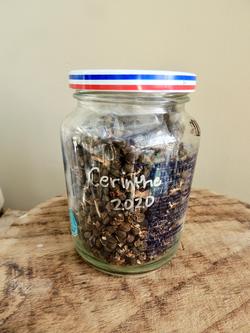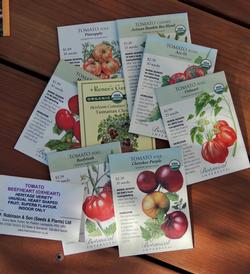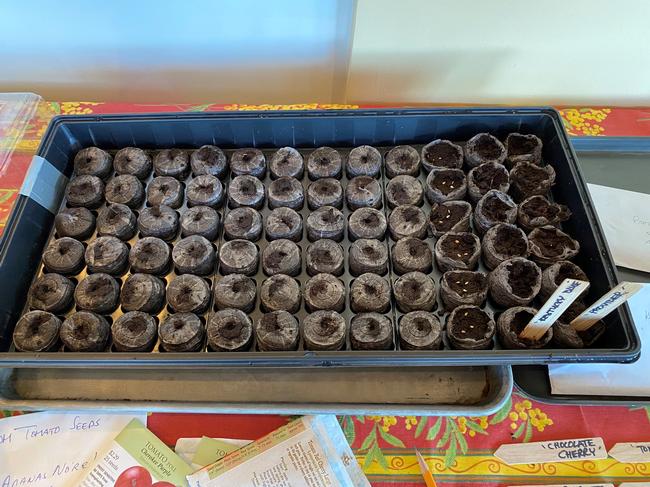The wonder of seeds
-
Diane Lynch
-
Have you ever looked at a seed and thought about the amazing potential in this unassuming brown package? Inside every seed is the embryo of a plant, ranging in size from tiny orchids to a giant sequoia or coast redwood. Seeds range in weight from some orchids at 0.0001 mg. to the double coconut, which can weigh 42 kilos or 92 pounds! Stay out from under that coconut tree! Life on earth wouldn’t have been the same without seeds.
Growing from seed offers many options of varieties not available at nurseries. Look through a seed catalog and be stunned by the plethora of lettuces alone—I counted 78 in one catalog. Many plants are happiest with seeds sown directly into the garden, such as lettuce, arugula, squash, peas, beets, carrots, snapdragons and nasturtiums. Some will germinate in as little as 5 days. Read packet instructions to thin them to establish proper spacing. You can allow lettuce to grow several weeks and then thin them for your first spring salad, leaving the strongest looking plants to grow larger. Saving seed in a sealed jar in a cool place will extend longevity. Photo: Diane Lynch
Saving seed in a sealed jar in a cool place will extend longevity. Photo: Diane LynchThe nice thing about seeds is that many are easy to grow, plus there’s hardly anything you can do in the garden that’s more satisfying than growing a plant from seed. Then, watching it go to seed and saving some for next year, is the ultimate gardener’s joy. Vegetables are especially fun to grow from seed since you eat the results. We’re heading into spring, which is the start of Marin’s prime vegetable growing season.
Along with vegetables, some flowers are best planted from seed. Nasturtium and love-in-a-mist will self-seed after flowering. Cerinthe will also, and it’s good for hummingbirds and beautiful paired with California poppies. Poppies also self-seed, if the birds don’t find them.
UC Marin Master Gardeners usually have a Tomato Market in late April, right before the time the plants should go into the garden, but due to the pandemic, it’s cancelled this spring. So, now is the best time to seed your own tomato plants. I’ve planted hundreds over the years and they are among the easiest seeds to grow. You can grow them on a sunny windowsill. I plant each variety in a plastic disposable fruit or vegetable clamshell from the grocery store, which creates a little greenhouse with good drainage. You could also use a pot. A couple of weeks after germination, transplant them into 4” pots. Keep them in the sunniest, warmest room in the house. As they grow taller, it’s time to harden them off. Move them outside in the sun where the stems will toughen up with some wind. If frost threatens, bring them in at night. Tomatoes are among the easiest of summer fruits to grow from seed. Save your seed from heirloom varieties to plant next year. Photo: Diane Lynch
Tomatoes are among the easiest of summer fruits to grow from seed. Save your seed from heirloom varieties to plant next year. Photo: Diane LynchTo save tomato seed for next year, be sure you are saving from heirloom or open-pollinated varieties. Hybrids usually won’t come true, or yield the same kind of plant as the original plant. There’s a little trick to saving tomato seed. As tomatoes start to ripen you’ll want to save seed from the best looking tomatoes that are fully ripe. Cut it in half and squeeze some seed into a small bowl and add a little water. Place on a sunny windowsill and wait for it to ferment, mold or get smelly, approximately 2 to 4 days. This breaks down the gelatinous covering, which inhibits germination. Pull off the moldy top and rinse the seed that settles, letting the gunk go down the drain. Spread the seed on a disposable coffee filter or paper plate and let it dry -- you can pick one seed off at a time when you plant next year. Date, label and store in a cool dry place such as a zip lock bag tucked into a jar with a secure lid. Some seed savers store their seeds in the refrigerator or freezer.
 Starting tomato seeds is easy. Poke 2-3 seeds per starter pot into the soil with the tip of a pencil. Label pots with the variety. Photo: Jill Fugaro
Starting tomato seeds is easy. Poke 2-3 seeds per starter pot into the soil with the tip of a pencil. Label pots with the variety. Photo: Jill FugaroPay attention to planting recommendations on seed packets. The last frost date for your area is important for summer plantings such as tomatoes, squash, peppers, and beans. Cool weather crops such as lettuce, peas, beets, and broccoli can withstand some cold. Happy growing, and eating!



